Phlox paniculata: varieties, planting and care
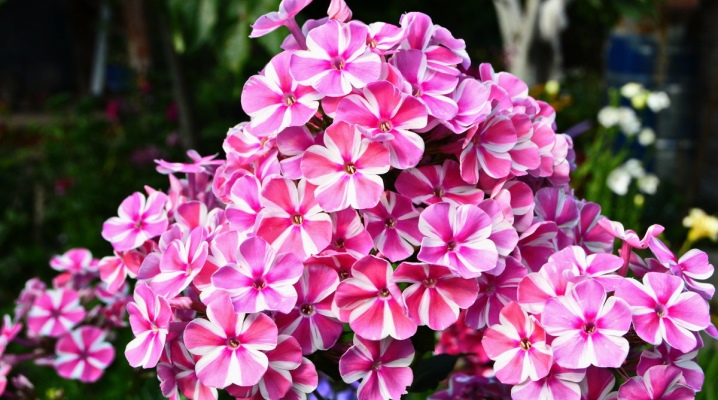
Among the wide variety of garden flowers, paniculate phlox stands out especially. Lush multi-colored hats adorn the plots of many summer residents. Consider a description of popular varieties, as well as the nuances of planting a culture and caring for it.


Peculiarities
Phlox paniculata is a perennial flowering culture. It is distinguished by a strong stem that lignifies before the onset of winter. The flower forms an erect bush, keeps its shape well. Many varieties of this group grow up to 100-150 cm, but there are also mini-variants that reach a small height (from 35-40 cm).
Earlier this culture was called "Torch". The fact is that initially there was only one of its colors - deep red. However, the works of breeders bore fruit and many different varieties of other shades were born. Snow-white, sky-blue, soft and bright pink, scarlet, purple flowers delight gardeners, transforming areas. There are only yellow tones in the palette of paniculate phloxes. There are also two-tone varieties. Combinations can be both gentle and contrasting, which allows widespread use of culture in landscape design.


The buds form spherical inflorescences. The flowers look like funnels, each consisting of 5 petals. The leaves are elongated. The root system of the plant is fibrous, large. Moreover, every year it increases in volume. She endures winter staunchly, in contrast to the aboveground part, which dies off. Since the roots can rise above the ground due to the increase in size, a little soil should be poured under the bush every spring. This will help the plant thrive and bloom beautifully.
Phloxes of this group bloom at different times, it all depends on the specific variety. This allows you to collect several varieties of crops on the site and enjoy lush flowering all summer. Interestingly, the buds open gradually. In all its glory, flowers appear before gardeners only in the second week of flowering. The pleasant scent of phlox is also worth mentioning.
It becomes a great addition to the decorative appearance of the culture.


Varietal variety
Consider several popular phlox varieties.
"Larisa"
A variety that blooms in early July. The color is very rare. Delicate salmon petals surround a violet center with contrasting snow-white edging. The flowers are quite large (up to 4 cm in diameter). The height of the plant is average - 55-60 cm. The culture is perfect for use as a centerpiece in a flower garden.

"Margri"
A spectacular variety combining 3 shades. The petals shimmer with milky and purple-lilac tones. There is a crimson circle in the center. The variety blooms in August-September, grows up to 80 cm.

"Olenka"
A variety with a gentle name will appeal to romantic natures. The pleasant pink shade of the petals is harmoniously combined with the crimson center in the white edging. The height of an adult flower is 85 cm. The culture pleases with flowering in July-August.

"Apple blossom" ("Apple blossom")
This is a medium-sized variety (50-60 cm), good in group and single plantings. The flowers are large - up to 5 cm in diameter. The color is pale pink at the edges of the petals and milky in the center. The color does not fade in the sun. The culture blooms from July to August.

"Margarita"
This variety will undoubtedly become a bright accent of the garden area. A deep red tone with a raspberry hue makes the flower very visible. The inflorescence is dense, the flowers are large (4.5 cm). Plant height can reach 90 cm. Flowering begins in July and ends in September.
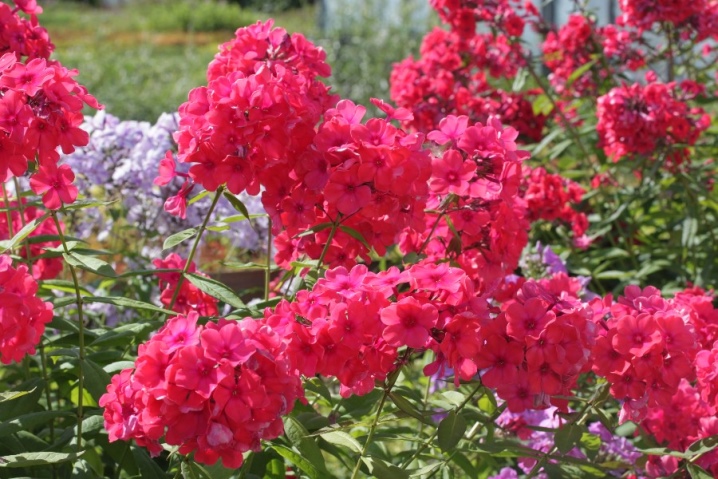
"Miss Mary" ("Miss Mary")
Another red variety. The height of the bush is from 60 to 80 cm. In the center of the flower, the hue barely changes to purple. Flowering coincides with the previous variety (begins in July and lasts until September).
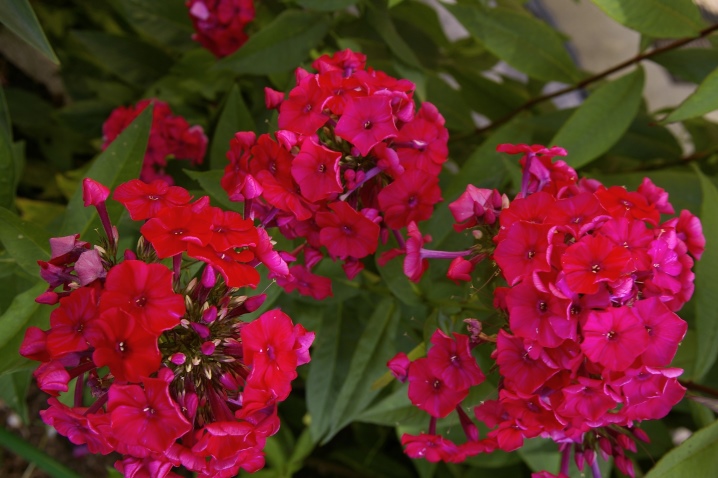
"Moskvichka"
Flowers with wavy petals create beautiful semi-double hats. The color is deep pink at the edges and pale pink in the center. The bush grows up to 80 cm. The average diameter of the flowers is 3.5 cm. The culture blooms in July.

"Vladimir"
Despite the "masculine" name, the variety has a light pink color with a darker center. At the edges, the petals are framed with a light border. Plant height - 70 cm. Flowering later (July-August).

"Mishenka"
This variety with its original colors resembles a collection of miniature striped umbrellas. A contrasting purple stripe is located in the center of each snow-white petal, creating a unique sight. The bush is compact, it grows up to 70-80 cm.
"Mishenka" blooms in July-August.
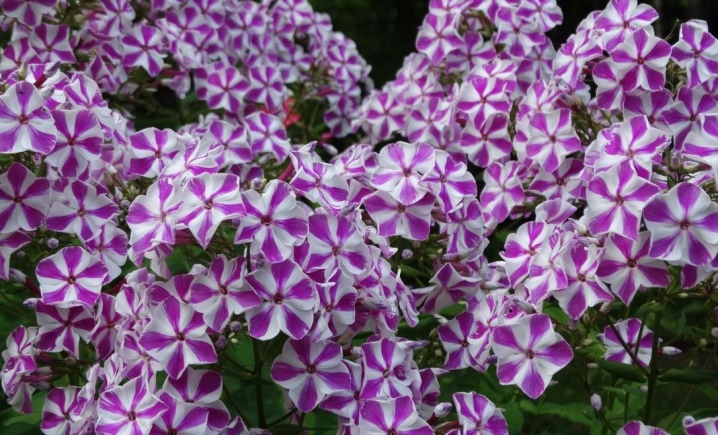
"Twister"
Another unusual striped variety. In this case, bright pink broad lines can be seen on the white petals. The bush is miniature - its growth reaches only 45 cm. Such flowers bloom in August and remain elegant until September. The variety loves the sun, blooms longer in an open area, without losing the brightness of the color.

"Old lighthouse"
This unusual flower really evokes retro associations. The petals are silvery gray in color. In the center of each flower you can see a purple-crimson "star". The growth of the culture is average - about 70 cm. The flowering period is from June to September.


Starfire
This vibrant variety of paniculata phlox features cherry red flowers. Bronze bloom on young leaves emphasizes the richness of the color. The height of the bush is 60-80 cm. The flowering of the variety lasts from July to September.

"Selena"
A variety with a delicate pink-purple color. At the same time, the petals seem to be covered with a translucent silvery coating. It is especially noticeable on cloudy days. The middle of the flower is decorated with a large white "star" with a pink border. The plant grows to 80 cm in height.
Flowering occurs in July-August.

"Pauline"
This variety will appeal to connoisseurs of cold tones. Wavy purple flowers in the evening become darker and more expressive. The growth of the culture is small - only 60 cm. It begins to bloom in July and pleases with beauty until September.

"Strawberry soufflé"
This “tasty” name was given to this phlox for a reason. The juicy salmon-strawberry shade of the petals delights many summer residents. The center of the flower is purple. The petals are wide, very beautifully shaped. The plant is quite tall - it can reach 110 cm, which increases its decorative effect and visibility on the site. The culture blooms from July to September.
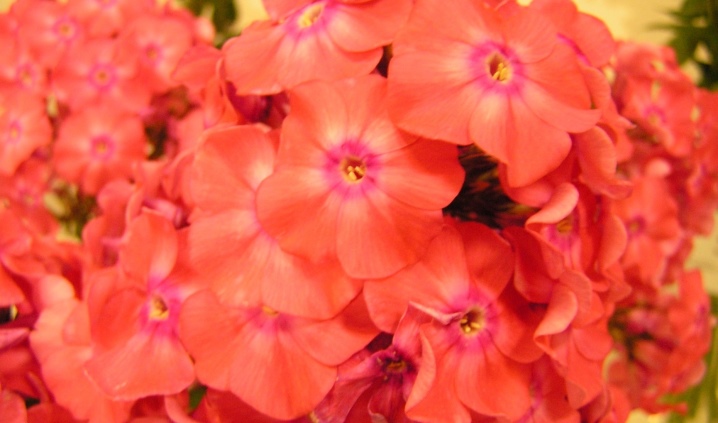
"La Traviata"
Not a very remarkable variety, which, however, also finds its fans. The burgundy-crimson color with a lighter center seems to be slightly dusty. The petals have a wavy structure. The flower will grow up to 80 cm. The plant blooms in late summer (in August).
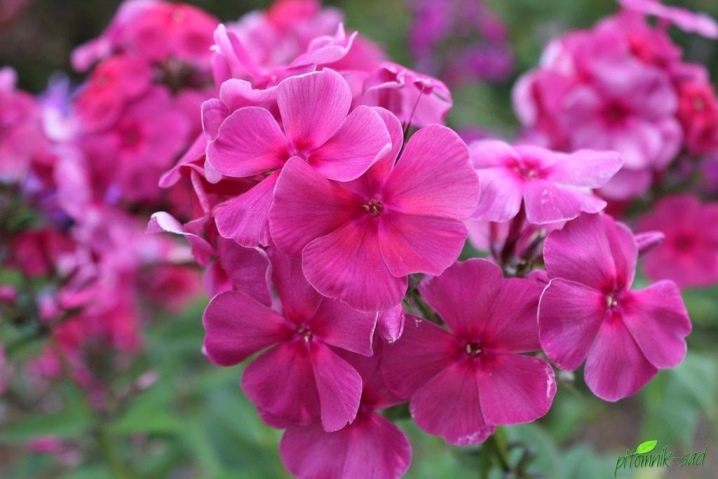
"Winter morning"
Another "telling" name. The pearly white flowers with a slight pinkish tint and pearlescent glow really create associations with sparkling snow. The maximum plant height is 90 cm. It blooms from July to September.

"Zephyr"
"Delicious" light pink petals with bright central blotches can transform any flower bed. The diameter of the flowers is 4 cm. The growth of the culture is 70 cm. Flowering lasts from the end of July to September. In a sunny place, the bush may lose pigment. Therefore, if you do not want the flowers to turn white, plant the plant in partial shade.

Miss Pepper
Another pink variety with a bright appearance. Delicate pink petals are arranged around a juicy crimson center. The height of the bush can reach up to 90 cm. The culture blooms in July-August.

Miss Ellie
The color of the petals of this variety is similar to the previous variety, but the contrast between light and dark pink is not so obvious here. The flowers are small (2.5 cm in diameter), star-shaped. The maximum growth of the culture is 1 m. It blooms in July-August.

Miss Holland
Airy snow-white charm with a bright pink center wins the hearts of many gardeners. The lush flowering of the culture lasts from mid-summer to August.
The bush can grow up to 80 cm.

"The Dragon"
The unusual name is consistent with the original color of the variety. Violet wide petals seem to be covered with a silvery haze. In the center is a dark purple "star". The silver bloom increases during the flowering process and gradually turns from a fine mesh into an almost continuous coating. The bush is strong, grows up to 90 cm. Flowering begins in July and ends with the onset of autumn.

Miss Kelly
Tenderness, embodied in lavender color, appears at the end of July. Large inflorescences are pleasing to the eye until September. The growth of the bush is average - about 80 cm. The best place for a flower will be an area with diffused lighting.

Miss Olga
Light pink flowers with a rich center appear at the end of July. The petals are not afraid of sunlight, they do not lose color juiciness. Plant height - 75-80 cm. The variety is distinguished by its strength, resistance to adverse conditions (rain, wind).

"Sherbet cocktail"
This variety, thanks to the efforts of the breeders, turned out to be extremely unusual. The shade of the petals ranges from pale pink to lilac. Along the edge is an olive yellow border. The culture can grow up to 120 cm. She does not tolerate the bright sun, prefers shaded places. The flowering period is from July to September.
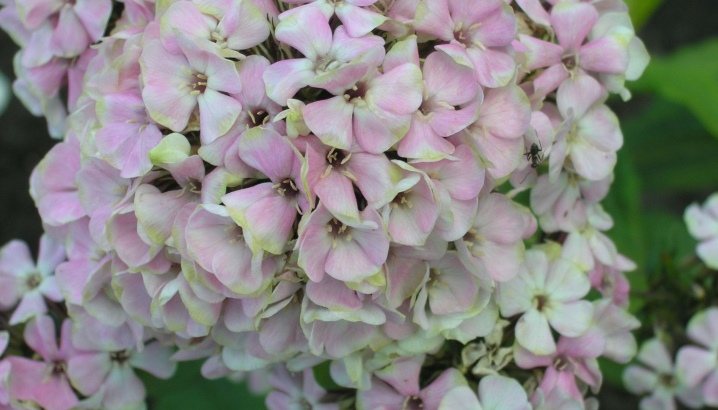
"Miniature"
As the name implies, the variety is distinguished by its small flowers. At the same time, he looks no less charming than his large-flowered relatives. Long bloom (June and July). Compact bush, grows up to 80 cm. Stems are thin, graceful. The color of the petals is pale lilac. At the edges, the flowers are lighter, almost white.

Site selection and soil preparation
Phloxes are not too whimsical. However, the selection of a suitable site for the placement of the crop is very important. In order for the plant to grow well and please with lush flowering, it is worth considering a few nuances.
- The illumination should be sufficient. Light shadow is acceptable. Some varieties prefer this kind of location. However, in full shade, the phlox will be uncomfortable. In such conditions, the plant will not bloom at full strength.
- The soil should be fertile, well-drained. Stagnation of water at the roots is unacceptable. The optimum acidity level is neutral. You can plant a flower in slightly acidic soil. If the soil is heavy (sandy or clayey), it should be improved before planting.


How to plant?
Planting crops can be done in different ways. Some people prefer to place the seeds directly in open ground. Others prefer varietal seedlings. The second option is considered a better choice, since the first method does not always lead to the desired result.
You can plant flowers on the site throughout the warm season. However, most gardeners do it in the spring. The seedling hole should have a depth of about 30 cm. The width should be sufficient so that the root system can be freely positioned. A fertile mixture is prepared for planting. The main components are ash, minerals and humus. The last component can be replaced with compost.
In this case, the amount of the organic component should be 30-40%.
All elements are shuffled.The hole is filled with the resulting mixture by 2/3. A small elevation is created in the middle. A seedling is placed on it. Then the roots of the flower are gently straightened. The pit is filled with soil to the end. An important point - the deepening of the root collar should be about 5 cm. Renewal buds should be immersed in the soil by at least 3 cm. In conclusion, the soil is tamped down, and abundant watering is carried out. If the weather is warm and dry, they continue to water for several more days.


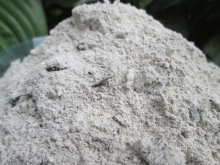
How to take care of it properly?
It was mentioned earlier about the need to add earth to the roots of the flower annually. This is a necessary procedure, otherwise the bare roots will freeze and the plant will die. The location of the root system close to the surface also makes it unacceptable to loosen the soil around the crop. There are other nuances of flower care.
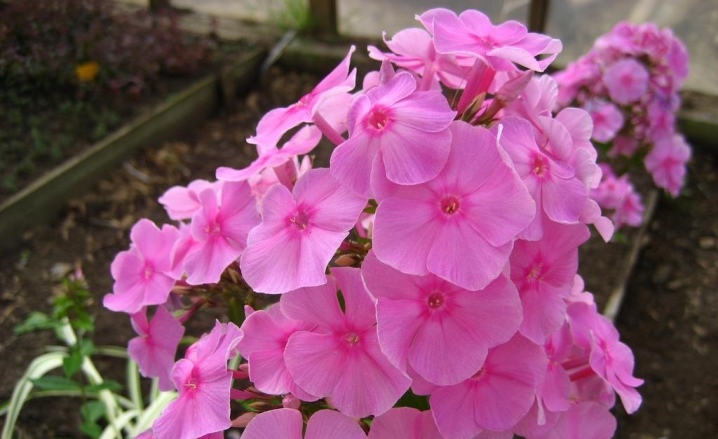
Watering
Phlox paniculata loves moisture, but in moderation. The abundance of watering depends on how dry the soil is. If the summer is hot and dry, about 2 buckets of water are consumed per 1 square meter at a time. Watering is best done in the evening. In this case, moisture will not quickly evaporate from the surface. If the weather is still without rains in the fall, they continue to water the phlox until October. This will allow the plants to accumulate enough moisture for wintering.

Top dressing
They begin to fertilize the flower in the second year after planting. Until this period, the culture has enough nutrients that were originally introduced into the well. During the season, feeding is usually done 3 or 4 times. The regularity of the procedures allows you to increase the flowering period of the culture and make it more lush.
In spring, nitrogen can be used. This allows the plant to quickly acquire fresh greens. When the shoots reach a size of 10 cm, you can spray with a urea solution. For 10 liters of water take 1 tbsp. spoon of the composition.
Before the formation of buds, the soil is mulched. In this case, humus, ash and a mineral composition suitable for ornamental flowering crops are used. After flowering, phosphorus-potassium agents are usually applied. The final top dressing is carried out in the fall. During this period, the soil is mulched with a mixture of organic matter and ash.



Pruning and garter
Tall phloxes need a garter. Otherwise, strong gusts of wind and rainfall can break the stems.
Before the onset of winter, the flowers must be cut off. Pruning is done at the root. The maximum can be left 10 cm, the minimum - 3. This procedure excludes the possibility of accumulation of pests and fungi between the shoots.
Also, the processes of mulching and preventive treatment of plants with fungicides are becoming simpler.


Preparing for winter
When choosing phlox for the garden, it is worth giving preference to varieties adapted to the local climate. Such plants are frost-resistant. They do not need a special shelter for the winter period. To protect the crop, organic mulch will be sufficient, which is laid in the fall.

Reproduction methods
Seed propagation of phlox is not very common. The flowers obtained in this way do not always have the qualities of the original variety. However, it will not be superfluous to know about the features of the process.
Sowing is carried out in the fall, immediately after collecting the material. The seeds are placed in the ground, making small grooves in it. Then they are sprinkled with a layer of soil. With the onset of spring, the seedlings are placed in separate containers and await the moment they are planted on the site.


Cutting is the more popular method. It allows you to preserve varietal characteristics. Cuttings are harvested in May. They are taken from healthy mature bushes. Each cutting should capture the middle part of the shoot and have 2 internodes. The lower leaves are cut off. The planting material is placed in a container filled with wet sand. Then it is covered with foil to create a mini-greenhouse conditions. The seedlings are regularly ventilated and sprayed with warm clean water.
A month later, the cuttings take root. New shoots appear.Young plants are transferred to an intermediate bed. There the final formation of the root system takes place. With the onset of autumn, each new crop is transplanted to a permanent place.


Sometimes the method of dividing the bush is also used. In this case, several new specimens are obtained from an adult flower. In spring or early autumn, the plant is carefully dug up. Then it is divided into several parts. Each part is planted in a permanent place. In the future, a full-fledged phlox will develop from the planting material.

Diseases and pests
The culture can be affected by powdery mildew. Excess watering is usually the cause of the disease. If trouble is found, the water procedures for the flower should be adjusted. It is also necessary to treat the bush with fungicides. Variegation is manifested by spots-strokes on the foliage. This disease cannot be cured. Therefore, in this case, the flower is destroyed.
Pests rarely attack phlox. However, sometimes a stem nematode appears on plants. In this situation, not only phlox, but also neighboring plants are at risk. It will not be possible to defeat the pest, since effective methods of control have not yet been invented.
The affected culture is dug up and burned.


Use in landscape design
Often the lower part of the plant stem is "bare". Therefore, it is a good idea to surround the flower with undersized ornamental plants. An excellent choice would be hosts, daylily. Other options are also possible.
Many gardeners combine phlox of different varieties on the same bed. For a more effective composition, it is worth combining contrasting colors (for example, white with purple, violet or red). If you want tenderness, you can combine whiteness with pale pink flowers. Phlox can be combined with other large flowering crops. For example, dahlias are great companions.



For information on how to grow paniculata phlox, see the next video.







































































































The comment was sent successfully.